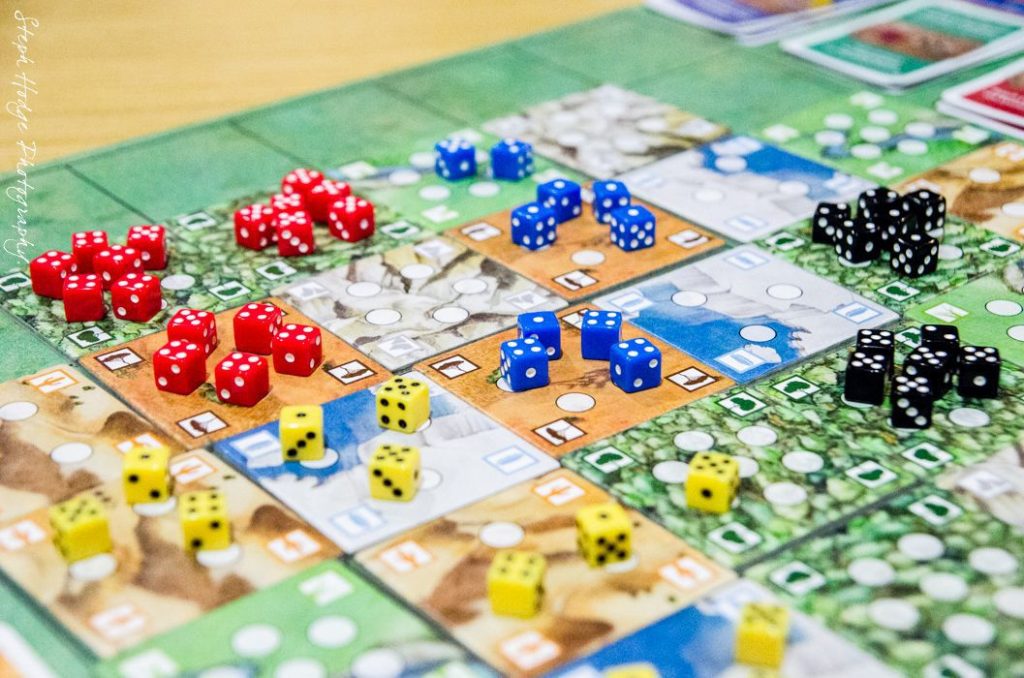This activity explores the dynamics of human-mediated biodiversity patterns.
Activity time: 1.5 hrs (can be split among two periods)
Game: Biosphere
Associated materials: paper- ‘What really is Evolution?’, paper- ‘Simulating evolution: how close do computer models come to reality?’, Homework/Discussion Materials
Activity:
-Assign and discuss primary literature that matches the learning objectives (see above for suggestions).
-Play Evolution: Climate by the publisher’s rules.
Urbanization
Game modification. Before playing get 12-20 ‘house’ game pieces from online, or borrow from another game (for example, Monopoly or Settlers of Catan).
Gameplay
Step-up and play Biosphere according to rules with a randomized board, except the following changes:
- Select 2 Habitat Points (= increased lifespan) at the game start in ANY habitat, this speeds up the early game progression
- Select goals non-randomly so that all are biologically relevant (& do not use purple goals)
- IGNORE TIE BREAKER TRACK- DO NOT DISCUSS
- All tiebreaker points go into EP bank
- If there is a tie, the number of EP points are the tiebreaker
- Use our biome lifespan cards (vs. ‘Elelphant graveyard’ dial) provided in the ‘Main Materials’ link.
- The gameplay is normal for the first two rounds.
- At the start of the 3rd round at the end of Phase 1, ‘Initial Buildings’ will be placed. The number of buildings placed equals the number of players.
Initial Building Placement
For each building placed into the wilderness:
- Roll 2 dice
- Without looking at die values gather the dice into a line
- The first and second die values corresponding to: x and y axis of the game board.
- Start at the top-left tile. Moving from left-right count the ‘x’ die values. Move to the right the number of tiles equivalent to the ‘x’ die value. If the value exceeds the number of tiles available, re-roll the die (or use a die with side equivalent to the tile width).
- From the selected tile, move down the number of tiles equivalent to the ‘y’ die value – this is the title that will experience urbanization this round. If the value exceeds the number of tiles available, re-roll the die (or use a die with side equivalent to the tile width).
- Pick one of the non-center circles within this selected tile. Announce its location to the group and then roll a 3rd Count the circles clockwise equivalent to the third die value — this is the site where the house will be placed. Any existing species are immediately returned to their owners.
- Repeat process for additional buildings
Example:
Die #1, value 4 = 4th row
Die #2, value 3 = 3rd column
Die #3, value 5 = 5th circle from selection
Subsequence Rounds Building Placement
For each building previously placed (urbanization expansion in already urban tiles):
- At the end of Phase 1, select one of the houses present and roll a die. If an even value, the next ‘non-house’ circle going clockwise becomes a house. If an odd value, the next non-house circle going counter-clockwise becomes a house. If every circle on the exterior is full, place in center (if present on the tile). Once the tile is ‘full’, no new houses can be placed.
- Repeat for every house on the board.
Also place one new house using the rules for initial building placement (urbanization in wilderness tiles)
Place the rest of the game by the publisher’s rules. Discuss how the ‘standard’ game and ‘urbanization scenario’ changed gameplay tactics and strategies.
NOTE: WHEN CALCULATING MAJORITIES ON TILES FOR DOMINANCE, houses count against majorities (as if equivalent to an opposing players die)

